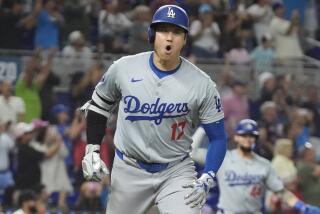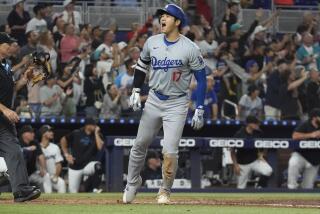Interleague Numbers Really Don’t Add Up
So Ken Griffey Jr., sets a major league record for home runs in April, and Tino Martinez sets another for runs batted in.
So what happens when that statistical wheel on which baseball revolves rolls into the interleague schedule in mid-June?
What happens if Randy Johnson of the Seattle Mariners strikes out 21 Dodgers--OK, that’s a stretch even if it is the Dodgers--on June 14 in the Kingdome?
Is it an American League record? A National League record? Neither?
According to the Elias News Bureau, keeper of baseball’s official statistics, Johnson would be credited with “the most strikeouts in a game by an American League pitcher” and the Dodgers would be credited--discredited?--with the National League record for the most strikeouts in a game by a team.
There is no special category for interleague statistics or records.
Any statistic achieved in an interleague game will be treated as if achieved in an intraleague game, according to an agreement between baseball and the players’ union.
Any record broken in an interleague game will be categorized by what uniform the record breaker is wearing.
“Baseball has a rich history of league records that shouldn’t be discarded lightly,” said Steve Hirdt, a senior statistician at Elias.
“At some point in the future, through realignment and teams switching leagues, that perception of separate league identities may change and there may be a call to simply group all records under one major league heading, but I don’t think we’re at that point now.
“Interleague play has been approved only on a limited basis for this year and next. We’re going to maintain separate league records based on the uniform the record breaker was wearing, not who he was playing against.”
In other words, if Larry Walker of the Colorado Rockies, who tied a National League record for home runs in April, hits 52 homers in National League games and five more in interleague games, he will be credited with having broken Hack Wilson’s National League record of 56 homers in a season.
If an American League player reels off a 40-game hitting streak but then goes hitless in an interleague game, the streak will have stopped.
At the same time, if a player is traded from one league to another, his statistics in the league he is leaving will be frozen, as always.
This is how Willie McGee won the 1990 National League batting title, even though Eddie Murray, then of the Dodgers, had the highest major league average of any player with enough plate appearances to qualify.
Murray batted .330. McGee was hitting .335 with the St. Louis Cardinals when traded to the Oakland A’s on Aug. 29. He hit .274 with the A’s to drop his overall average to .324, but he was still credited with a National League mark of .335 to outpoint Murray.
Similarly, David Cone, then of the New York Mets, led the major leagues in strikeouts in 1992 but was never credited as a strikeout champion.
Cone struck out a total of 261 batters that year, but 47 came after he was traded to the Toronto Blue Jays. He lost the National League crown to John Smoltz, 215-214, and the Mariners’ Johnson won the AL title with 241.
The maintenance of separate league records has made baseball unique. In the NFL, for instance, Eric Dickerson, then of the Rams, holds the record for most rushing yards in a season--2,105.
Nobody thinks of O.J. Simpson, then of the Buffalo Bills, as the American Football Conference record-holder at 2,003. He is simply second in the NFL to Dickerson.
Eventually, baseball may fit that mold. Sweeping realignment for 1999 or 2000 could find six or more teams changing leagues, further blurring identity, tradition and league boundaries.
In the meantime, the current interleague process is rife with scheduling inequities that could affect races and statistical possibilities troubling to many critics and purists. Joe Torre, the New York Yankee manager, said he isn’t sure he fits that mold, but “it’s pretty weird to think that a player could win the American League batting title by going lights out against the National League, or vice versa.”
Added Lyle Spatz, chairman of the record committee for the Society for American Baseball Research: “Suppose a guy like Craig Biggio DH’s for the Houston Astros in an interleague game and gets six hits to set a new record for most hits in a game by a DH who represents a league that doesn’t recognize the DH. It’s theater of the absurd.”
Spatz suggests that it would be best now to have just major league leaders and records, rather than separate American and National League leaders and records.
Said Hirdt, the Elias statistician: “It’s conceivable we may confront some oddities, but I think we’re prepared to deal with it.”
One thing is certain: The offensive onslaught of the last few years can no longer be considered an oddity. It’s here to stay.
The April averages of 2.06 homers per game and 10.5 runs per game were consistent with last year’s totals of 2.2 homers and 10.07 runs and consistent with the barrage of the ‘90s.
A remarkable total of five players--Griffey, Walker, Martinez, Roberto Alomar and Matt Williams--each hit three homers in a game during a very cold and inclement April.
And when the weather warms up? Statisticians will be working overtime even without interleague play.
More to Read
Are you a true-blue fan?
Get our Dodgers Dugout newsletter for insights, news and much more.
You may occasionally receive promotional content from the Los Angeles Times.








